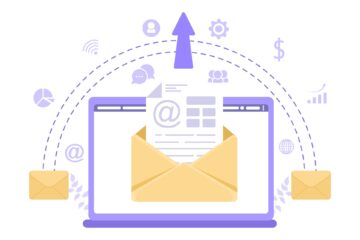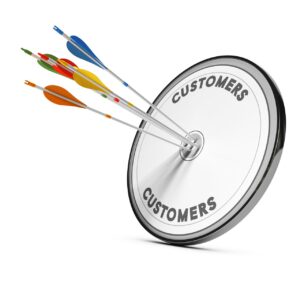Field Sales Prospecting isn’t a one-time task; it’s the essential energy that keeps your sales pipeline flowing.
But let’s be straightforward, relying solely on traditional methods isn’t enough in today’s digital age. You require modern strategies that match the evolving buyer landscape.
That’s where our comprehensive guide comes in. We’ve handpicked 20 sales prospecting techniques that not only deliver impact but are also perfectly suited for today’s field professionals.
So, are you ready to transform your sales approach? Are you prepared to fill your pipeline with top-notch leads that convert? If your answer is a definite “Yes,” then dive in. This guide is your pathway to achieving excellence in prospecting.
1. The Power of Referrals
Remember that euphoria when a friend raved about a hidden gem of a restaurant, and it turned out to be spot-on? That’s the essence of referrals.
In field sales, referrals are gold. They come with a trust seal, eliminating the initial barriers.
Tips for Acquiring High-Quality Referrals
- Ask Actively: Don’t shy away. After a successful deal, ask satisfied clients if they know anyone who might benefit from your product.
- Nurture Relationships: Regular check-ins, even a simple “how are you,” can work wonders. It’s these relationships that often lead to referrals.
- Leverage Testimonials: Encourage satisfied clients to share their positive experiences. A glowing testimonial can serve as a passive referral, influencing potential clients.
- Host Referral Programs: Offer incentives or discounts to clients who refer others. This not only encourages referrals but also shows appreciation for their effort.
- Engage in Community Events: Being active in community or industry events can lead to organic conversations and, subsequently, referrals.
Referral leads have a 30% higher conversion rate than leads from other channels. Now, that’s food for thought!
2. Digital Insights & Social Media
Ever done a little social media snooping before a date or a meeting? (It’s okay, your secret’s safe here!) Now, imagine harnessing that for sales.
Social media isn’t only about funny memes and travel photos; it’s a valuable source of information. But how can you filter out the distractions?
- LinkedIn Advanced Search: Use this tool to refine prospects by location, company, job role, and more. It’s like having a magnifying glass for the online world.
- Twitter Insights: Monitor brand mentions, join relevant conversations, and understand a prospect’s pain points.
- Facebook Business Suite: Dive into analytics to understand audience behavior, track engagements, and identify potential leads from interactions.
- Google Alerts: Set up alerts for industry keywords or potential client names. This way, you’re instantly notified when they’re mentioned online, giving you a timely opportunity for outreach.
- Instagram Explore: For businesses with a visual component, the Explore section can help identify trending topics and influencers in your industry. Engage with them to expand your reach and visibility.
A staggering 75% of B2B buyers use social media to make purchasing decisions. Are you leveraging this yet?
3. Contact Sourcing Innovations
Gone are the days of sifting through directories or cold calling from outdated lists. In today’s digital era, there’s a wide array of tools available to find contacts.
However, with numerous options, which ones deserve your attention?
- Hunter.io: Perfect for finding email addresses associated with a particular domain.
- Voila Norbert: Another gem for email sourcing. Just input the name and domain, and let Norbert do the magic.
- GetProspect: An excellent tool for LinkedIn integration. It allows you to find business emails and build a list of leads.
- Snov.io: This platform offers a Chrome extension to find emails while browsing websites or LinkedIn profiles. It also provides a verifier to check the deliverability of email addresses.
- Adapt.io: A unified platform with a robust tool for finding business emails. It also integrates seamlessly with popular CRMs, enhancing your workflow.
4. Targeted Solutions for Pain Points
Recognizing a prospect’s pain points equates to possessing a detailed blueprint that leads directly to their needs and desires. These pain points, when accurately identified, reveal the specific challenges and hurdles a prospect faces, offering sales reps a clear direction on how to tailor their approach.
Offering targeted solutions for pain points demonstrates a deep understanding and empathy towards the prospect’s challenges, fostering trust and credibility.
Furthermore, targeted solutions ensure that the pitch is relevant and resonates with the prospect’s actual needs, eliminating generic pitches that often fall on deaf ears.
Tips for Offering Targeted Solutions for Pain Points
- Surveys and Feedback Forms: Use tools like SurveyMonkey or Google Forms to gather insights directly from your prospects or existing clients.
- Competitor Analysis: Understand where competitors fall short. This can highlight potential pain points you can address.
- Engage in Conversations: Whether it’s a casual chat or a formal meeting, listening can reveal underlying issues.
- Join Industry Forums: Platforms like Quora or industry-specific forums can be goldmines for understanding common challenges.
- Feedback from Sales Team: Your team is on the front lines. Regular debriefing sessions can offer invaluable insights.
By consistently addressing pain points with precision, sales reps can build a reputation for being problem solvers, making them the go-to professionals in their domain.
5. Deep Dive into Business Ecosystems
To truly resonate with your prospects, you need to understand not just their business but the entire ecosystem they operate in. But how?
- Industry Reports: Sources like Statista or IBISWorld can provide comprehensive insights into specific industries.
- Networking Events: Engage in industry-specific events or webinars. The conversations here can be enlightening.
- Follow Industry News: Stay updated with platforms like Google News or industry-specific publications.
- Engage with Thought Leaders: Following and engaging with industry thought leaders on platforms like LinkedIn can offer deep insights.
- Use Analytical Tools: Platforms like SEMrush or Ahrefs can provide insights into market trends and competitor analysis.
6. Inbound Prospecting Mastery
Inbound prospecting is a strategic approach in sales where potential clients come to you, primarily driven by content marketing, SEO, and other digital strategies.
Instead of reaching out to prospects directly, you create valuable content and experiences tailored to them, attracting qualified prospects to your products or services.
- Content Creation: Regular blog posts, whitepapers, or e-books can attract prospects.
- SEO Optimization: Tools like Yoast SEO can ensure your content ranks high on search engines.
- Engaging Webinars: Host webinars on industry topics. Not only do they position you as an expert, but they also attract prospects.
- Social Media Promotion: Regularly promote your content on platforms like LinkedIn, Twitter, or even Instagram.
- Engage in Online Communities: Platforms like Reddit or industry-specific forums can be great places to share your content and engage with prospects.
Mastering inbound prospecting ensures a steady stream of warm leads who are already interested in what you offer, reducing the time and effort typically spent on cold outreach.
Additionally, by providing value upfront through content and resources, you establish trust and credibility with prospects, laying a solid foundation for a successful sales relationship.
7. Social Media Engagement
Social media engagement refers to the interactions and relationships built on social platforms, leveraging them as tools for business outreach and connection.
Tips for Leveraging Social Media for Field Sales Prospecting
- Consistent Posting: Regular updates about industry news, your product, or even behind-the-scenes glimpses can keep your audience engaged.
- Engage with Comments: Don’t just post; interact. Reply to comments, engage in discussions, and foster a community feel.
- Use Ads Strategically: Platforms like Facebook and LinkedIn offer targeted advertising options to reach your ideal prospects.
- Host Live Sessions: Platforms like Instagram and Facebook allow live interactions. Use them for Q&A sessions, product demos, or expert chats.
- Share User-Generated Content: Sharing reviews, testimonials, or customer-generated posts can boost credibility and engagement.
In field prospecting, effective social media engagement allows sales reps to tap into vast networks of potential customers, fostering genuine connections in spaces where prospects already spend their time.
8. Networking Globally
The world is your oyster, especially in the digital age. How can you expand your network beyond local boundaries?
- Attend International Conferences: Even if they’re virtual, they offer a chance to meet industry peers and prospects.
- Join Global Online Communities: Platforms like Slack have global industry-specific communities.
- Collaborate on International Projects: Work on collaborative projects or case studies with international partners.
- Leverage LinkedIn’s Global Reach: Connect with and engage industry professionals from around the world.
- Learn About Cultural Nuances: Understanding cultural differences can be a game-changer in global networking.
9. Outbound Prospecting Strategies
Outbound prospecting involves proactive outreach to potential customers, typically through cold calls, emails, and direct marketing.
Despite the rise of inbound methods, outbound prospecting remains a vital strategy because it allows sales reps to directly target and engage with specific potential clients, ensuring a more tailored approach.
Moreover, it provides immediate feedback, enabling teams to quickly adjust their strategies and pitches based on real-time responses.
- Personalize Your Outreach: Generic messages are out. Tailored pitches are in.
- Use Tools for Efficiency: Platforms like Outreach.io can streamline your outbound processes.
- A/B Test Your Approaches: What works for one might not work for another. Regularly test and refine your strategies.
- Stay Updated with Industry Trends: Your pitch should resonate with current industry challenges and needs.
- Follow Up, But Don’t Pester: Persistence is key, but there’s a fine line between following up and being intrusive.
10. Precision Customer Segmentation
This involves categorizing potential clients based on specific criteria and ensuring tailored and relevant outreach.
By targeting messages accurately, sales reps can enhance engagement, improve conversion rates, and foster stronger relationships with potential customers.
Tips for Efficient Customer Segmentation
- Use CRM Tools: Platforms like Salesforce or HubSpot allow detailed customer segmentation.
- Understand Buyer Personas: Craft detailed buyer personas to tailor your messaging.
- Analyze Purchase Histories: Past behaviors often predict future actions. Use them to segment accordingly.
- Survey Your Audience: Direct feedback can offer insights into how to segment your audience better.
- Regularly Update Segments: Customer needs evolve. Ensure your segments do too.

11. Rekindling Relationships with Former Clients
Old flames can reignite, and the same goes for past clients. Rekindling relationships with former customers in field sales prospecting offers an opportunity to tap into a previously established trust, eliminating the need to start from scratch.
These revived connections can lead to repeat business, referrals, or valuable feedback, all of which can enhance and streamline the prospecting process.
So, how can you re-establish connections and turn them into potential leads again?
- Regular Check-ins: A simple “how have you been?” can rekindle a conversation.
- Offer Special Deals: Exclusive offers for past clients can reignite interest.
- Share Updates: Inform them about new products or features they might find beneficial.
- Seek Feedback: Ask them why they left and if there’s anything you can do better now.
- Host Alumni Events: Organize events or webinars specifically for past customers.
Reconnecting with former clients not only boosts sales potential but also strengthens brand loyalty and trust.
12. Leveraging Sales Technology
Sales technology encompasses a range of digital tools and platforms designed to optimize and enhance the sales process.
Leveraging sales technology is crucial in field sales as it streamlines operations, from lead generation to conversion, ensuring efficiency and accuracy. And with the right technology, sales reps can access real-time data and insights, allowing them to tailor their approach and engage prospects more effectively.
- CRM Systems: Tools like Zoho or Microsoft Dynamics can streamline client management.
- AI-Powered Insights: Platforms like InsideSales.com offer AI-driven insights to optimize sales strategies.
- Automated Email Campaigns: Tools like Mailchimp can automate and personalize email outreach.
- Sales Analytics: Understand sales metrics better with platforms like Tableau.
- Virtual Demos: Use tools like Zoom or Skype for product demos to global customers.
Embracing technology not only streamlines the sales process but also offers a competitive edge in understanding and reaching potential customers.
13. Crafting Engaging Email Campaigns
Email is far from obsolete; it’s transforming. And it’s essential to ensure your email campaigns don’t end up in the Spam or Trash folders, or worse, deleted without being opened or read.
Tips for Crafting Engaging Email Campaigns
- Personalized Subject Lines: Capture attention right from the inbox.
- Interactive Content: Embed videos or interactive graphics to engage the reader.
- Segmented Campaigns: Tailor your emails based on the recipient’s stage in the sales funnel.
- A/B Testing: Continuously refine your emails based on what resonates best.
- Clear CTA: Ensure every email has a clear and compelling call to action.
An engaging email campaign can turn passive readers into active leads, making it a crucial tool in a sales rep’s arsenal.
14. Effective Event Networking
Events, whether virtual or physical, are networking goldmines. How can you make the most of them?
- Pre-Event Research: Know who’s attending and prioritize whom you want to connect with.
- Engaging Elevator Pitch: Have a concise yet compelling pitch ready.
- Collect and Distribute Business Cards: Old school, but they work.
- Engage in Workshops: Active participation can boost visibility.
- Post-Event Follow-up: Connect on LinkedIn or send a thank-you email post-event.
Events offer a unique opportunity to connect directly with prospects, making them invaluable for expanding one’s network and fostering relationships.
15. Harnessing Content for Prospecting
Content for prospecting refers to the creation and distribution of valuable, relevant materials designed to attract and engage potential clients.
Utilizing content in field sales prospecting establishes authority and expertise in a specific domain, positioning the salesperson as a trusted resource.
Moreover, well-crafted content addresses the needs and challenges of prospects, fostering genuine connections and paving the way for meaningful sales conversations.
- Regular Blogging: Share insights, news, and tips relevant to your industry.
- Whitepapers and E-books: Offer in-depth knowledge that positions you as an expert.
- Webinars: Engage prospects in real-time with valuable content.
- Infographics: Visual content can simplify complex topics and attract shares.
- Case Studies: Showcase success stories to build credibility.
Quality content not only attracts prospects but also establishes trust and authority in your domain.
16. Mastering LinkedIn Dynamics
LinkedIn isn’t just a platform for job seekers; it’s a goldmine for sales reps. With a user base of professionals and decision-makers, it’s a platform where deals are initiated and closed.
Tips for Mastering LinkedIn Dynamics
- Optimized Profile: Ensure your profile highlights your expertise and value proposition.
- Join Relevant Groups: Engage in discussions and share insights in industry-specific groups.
- Use LinkedIn Ads: Targeted ads can help you reach decision-makers in specific industries.
- Publish Regularly: Share articles, insights, and updates to stay visible in your network.
- Engage with Comments: Interaction boosts your visibility and fosters relationships.
LinkedIn, when used strategically, can be a game-changer in B2B sales prospecting, opening doors to valuable connections and opportunities.
17. The Art of Cold Calling
While cold calling might appear outdated in the digital era, it’s still relevant. When executed effectively, it’s a direct connection to your prospect, providing instant feedback and interaction.
So, how can you turn cold calls into warm conversations?
- Research Before Calling: Know a bit about the person and company you’re calling.
- Craft a Strong Opening: First impressions matter; ensure you capture attention immediately.
- Practice Active Listening: Address the prospect’s needs and concerns genuinely.
- Use a Script, But Be Flexible: A script can guide, but be ready to adapt based on the conversation.
- Handle Rejections Gracefully: Every no brings you closer to a yes.
Cold calling, with the right approach and mindset, can still be a potent tool in a sales rep’s toolkit, bridging the gap between you and potential customers.
18. Nurturing Leads Effectively
Lead nurturing is the process of developing and reinforcing relationships with potential clients throughout the buying journey.
In field sales prospecting, effective lead nurturing ensures that potential prospects remain engaged and feel valued, increasing the likelihood of conversion. By consistently addressing their needs and concerns, sales reps can build trust and move prospects smoothly through the sales funnel, maximizing the chances of a successful sale.
- Regular Follow-ups: Consistency in communication keeps you on the prospect’s radar.
- Share Valuable Content: Send them relevant articles, case studies, or news.
- Personalize Interactions: Address them by name and reference previous interactions.
- Use Lead Scoring: Prioritize leads based on their likelihood to convert.
- Feedback Loops: Understand their concerns and address them promptly.
Lead nurturing is an art, ensuring that potential customers feel valued and understood, paving the way for successful conversions.
19. Effective Time Management
In sales, time is indeed money. Effectively handling it can determine whether you miss an opportunity or seal the deal. So you have to be certain you’re optimizing every second.
Best Practices for Effective Time Management
- Prioritize Tasks: Focus on high-impact activities first.
- Use Digital Tools: Platforms like Trello or Asana can help manage tasks.
- Set Clear Goals: Know what you aim to achieve daily, weekly, and monthly.
- Avoid Multitasking: Focus on one task at a time for better efficiency.
- Allocate Time for Prospecting: Ensure it’s a regular part of your routine.
Time management is crucial in sales, ensuring that no opportunity slips through the cracks and every lead is pursued diligently.
20. Building Trust with Prospects
Building trust with prospects involves establishing credibility, reliability, and genuine interest in addressing their needs.
By fostering trust, sales reps can differentiate themselves in a saturated market, ensuring that their pitches resonate authentically and effectively with potential prospects.
- Be Genuine: Authenticity goes a long way in building trust.
- Share Testimonials: Let satisfied clients speak for you.
- Be Transparent: Honesty, especially in addressing concerns, builds credibility.
- Consistent Communication: Regular updates and check-ins show you care.
- Educate Rather Than Sell: Offer value and insights, not just a sales pitch.
Building trust is a continuous process, laying the groundwork for long-term relationships and repeated sales.
Final Thoughts | Leveraging Modern Sales Prospecting Techniques
In the ever-changing world of field sales, staying ahead is crucial. As we’ve explored these field sales prospecting techniques, it’s clear that combining traditional methods with modern digital tools can lead to success.
But remember, techniques are tools; it’s your passion, authenticity, and dedication that truly connect with prospects.
As you go forth armed with these insights, focus on building real connections, understanding issues, and offering tailored solutions.
And if you seek a platform to streamline sales and boost your prospecting, take a look at Beest.app. It’s designed to empower field sales reps like you, ensuring you’re always at your best. Ready to transform your sales journey? Book your free demo today!

Frequently Asked Questions
What is sales prospecting?
Sales prospecting is the process of identifying and reaching out to potential clients or leads to generate new business opportunities. It involves a combination of research, outreach, and relationship-building strategies to convert prospects into customers.
How do modern sales prospecting techniques differ from traditional ones?
Modern sales prospecting techniques often integrate digital tools and platforms, such as social media and CRM systems, to streamline and enhance the outreach process. While traditional methods like cold calling still hold value, modern techniques focus on personalized, data-driven approaches to engage prospects more effectively.
Why is content important in sales prospecting?
Content plays a pivotal role in attracting and engaging prospects by offering valuable insights and solutions to their challenges. Through quality content, sales reps can establish authority, build trust, and nurture leads throughout the buying journey.
How can social media be used in sales prospecting?
Social media platforms offer a space to connect with potential clients, share valuable content, and engage in real-time conversations. By actively participating and building a strong online presence, sales reps can tap into vast networks and generate warm leads.
What’s the significance of nurturing leads in the sales prospecting process?
Lead nurturing involves building and reinforcing relationships with potential clients, ensuring they remain engaged and move smoothly through the sales funnel. Effective nurturing increases the likelihood of conversion, turning potential leads into loyal customers.

















